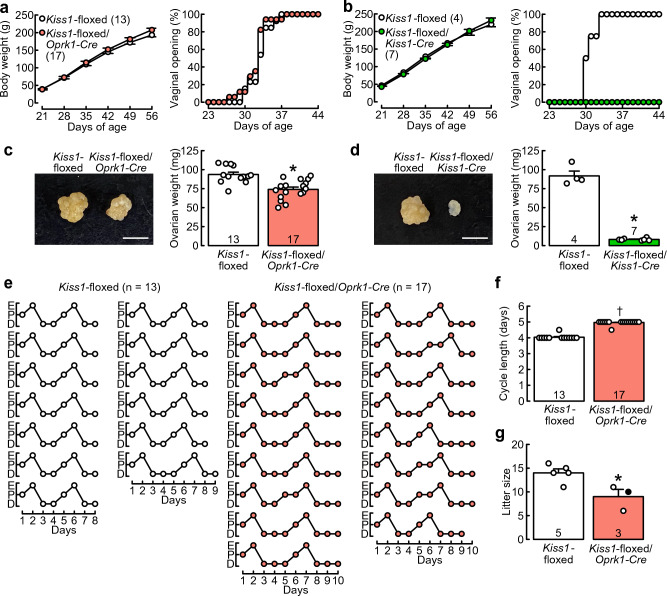Figure 2.
Kiss1-floxed/Oprk1-Cre female rats showed puberty onset, estrous cycles, and fertility, whereas Kiss1-floxed/Kiss1-Cre female rats lacked puberty onset. Growth curves and puberty onset in Kiss1-floxed/Oprk1-Cre female rats and their counterpart Cre(−)/Kiss1-floxed female rats (a) or Kiss1-floxed/Kiss1-Cre female rats and their counterpart Cre(−)/Kiss1-floxed female rats (b). Body weights are the means ± SEM. Numbers in parentheses indicate the number of animals used. The timing of vaginal opening as an external sign of puberty onset is expressed as a percentage of the total number of animals in each group. Representative photographs of ovaries and ovarian weights of Kiss1-floxed/Oprk1-Cre rats and their counterpart Cre(−)/Kiss1-floxed rats (c) or Kiss1-floxed/Kiss1-Cre rats and their counterpart Cre(−)/Kiss1-floxed rats (d). Scale bars, 5 mm. Open circles indicate the individual data. (e) Individual data of estrous cycles from the Kiss1-floxed/Oprk1-Cre group and Cre(−)/Kiss1-floxed control group. E, estrus; P, proestrus; and D, diestrus. (f) Cycle length (on average of two consecutive cycles) of Kiss1-floxed/Oprk1-Cre and Cre(−)/Kiss1-floxed groups. A dagger indicates a statistically significant difference (p < 0.05) between the groups based on the Wilcoxon rank sum test. Open circles indicate the individual data. (g) Litter sizes of Kiss1-floxed/Oprk1-Cre and Cre(−)/Kiss1-floxed female rats, which were mated with Iar:Wistar-Imamichi stud male rats. Values are the means ± SEM. Open (pups were delivered on gestational Day 22) and closed (pups were delivered on gestational Day 23) circles indicate the individual data. Numbers in (or on) each column indicate the number of animals used. Asterisks indicate statistically significant differences (p < 0.05) between the groups based on Student’s t-test.

